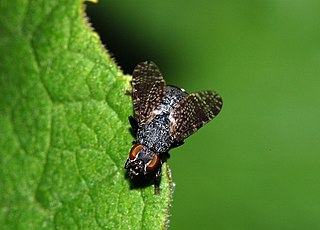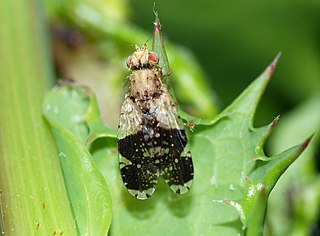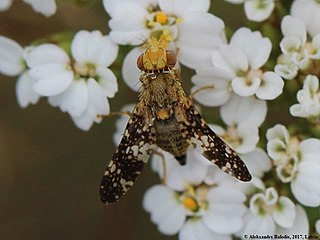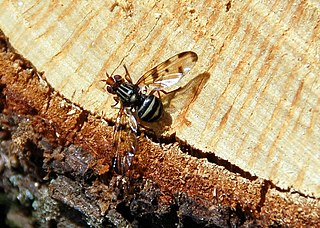Related Research Articles

The Drosophilidae are a diverse, cosmopolitan family of flies, which includes fruit flies. Another unrelated family of flies, Tephritidae, also includes species known as "small fruit flies". The best known species of the Drosophilidae is Drosophila melanogaster, within the genus Drosophila, and this species is used extensively for studies concerning genetics, development, physiology, ecology and behaviour. This fruit fly is mostly composed of post-mitotic cells, has a very short lifespan, and shows gradual aging. As in other species, temperature influences the life history of the animal. Several genes have been identified that can be manipulated to extend the lifespan of these insects. Additionally, Drosophila subobscura, also within the genus Drosophila, has been reputed as a model organism for evolutionary-biological studies.

The Tephritidae are one of two fly families referred to as fruit flies, the other family being the Drosophilidae. The family Tephritidae does not include the biological model organisms of the genus Drosophila, which is often called the "common fruit fly". Nearly 5,000 described species of tephritid fruit fly are categorized in almost 500 genera of the Tephritidae. Description, recategorization, and genetic analyses are constantly changing the taxonomy of this family. To distinguish them from the Drosophilidae, the Tephritidae are sometimes called peacock flies, in reference to their elaborate and colorful markings. The name comes from the Greek τεφρος, tephros, meaning "ash grey". They are found in all the biogeographic realms.

The Ulidiidae or picture-winged flies are a large and diverse cosmopolitan family of flies (Diptera), and as in related families, most species are herbivorous or detritivore. They are often known as picture-winged flies, along with members of other families in the superfamily Tephritoidea that have patterns of bands or spots on the wings. Some species share with the Tephritidae an unusual elongated posteroapical projection of the anal cell in the wing, but can be differentiated by the smoothly curving subcostal vein. Two species, Tetanops myopaeformis and Euxesta stigmatias, are agricultural pests.

The Tephritoidea are a superfamily of flies. The following families are included:

Odiniidae is a small family of flies. There are only 58 described species but there are representatives in all the major biogeographic realms.

The Platystomatidae are a distinctive family of flies (Diptera) in the superfamily Tephritoidea.
Paracantha is a genus of fruit flies in the family Tephritidae. There are about 10 described species in Paracantha.

The Pyrgotidae are an unusual family of flies (Diptera), one of only two families of Cyclorrhapha that lack ocelli. Most species are "picture-winged", as is typical among the Tephritoidea, but unlike other tephritoids, they are endoparasitoids; the females pursue scarab beetles in flight, laying an egg on the beetle's back under the elytra where the beetle cannot reach it. The egg hatches and the fly larva enters the body cavity of the beetle, feeding and eventually killing the host before pupating. In the United States, some species of Pyrgota and Sphecomyiella can be quite common in areas where their host beetles are abundant. Like their host beetles, these flies are primarily nocturnal, and are often attracted to artificial lights.
Hendrella is a genus of tephritid or fruit flies in the family Tephritidae.

Neotephritis is a genus of tephritid or fruit flies in the family Tephritidae.
Oedaspis is a genus of tephritid or fruit flies in the family Tephritidae.

Tephritis is a genus of flies. It contains around 170 described species, making it the sixth largest genus in the family Tephritidae. Many more undescribed species are known from specimen collections. Tephritis occur throughout much of the world, but most are Palearctic. They can be found in a wide range of climate types, from hot semidesert to tundra. Most species inhabit the inflorescences of plants from several tribes in the family Asteraceae, and a few species cause galls to form.

Terellia is a genus of tephritid or fruit flies in the family Tephritidae.

Urophora is a genus of tephritid or fruit flies in the family Tephritidae.

Oxyna is a genus of fruit flies in the family Tephritidae. There are at least 20 described species in Oxyna.

Otitinae is the name of a subfamily of flies in the family Ulidiidae. It was formerly the Otitidae. Like the Ulidiinae, most species are herbivorous or saprophagous. Most species share with the Tephritidae an unusual elongated projection of the anal cell in the wing, but can be differentiated by the smoothly curving subcostal vein. Most are dull gray to shiny brown or black flies with vein R1 setulose or, in a few cases, bare.

The Ulidiinae are a subfamily of flies in the family Ulidiidae. Like the Otitinae, most species are herbivorous or saprophagous. Most species share with the Tephritidae an unusual elongated projection of the anal cell in the wing, but can be differentiated by the smoothly curving subcostal vein. Most are dull gray to shiny brown or black flies with vein R1 setulose or, in a few cases, bare.

Tephritis arnicae is a species of picture-winged fly of the family Tephritidae, which are variously known as fruit-flies or gall flies.
Eupyrgota is a genus of flies in the family Pyrgotidae. A number of its species were originally from Apyrgota and Taeniomastix, which in 2014 were made synonyms of Eupyrgota by V. Korneyev.

Myopitini is a tribe of tephritid or fruit flies in the family Tephritidae.
References
- ↑ Kertész, K. (1903). "Eine neue Familie der acalyptraten Musciden". Annales Musei Nationalis Hungarici. 1: 355–358 & plate 15.
- ↑ Bischof, J. (1903). "Neue Dipteren aus Afrika". Wiener Entomologische Zeitung. 22: 41–42. doi:10.5962/bhl.part.9735.
- ↑ Malloch, J. R. (1931). "Exotic Muscaridae (Diptera) — XXXII". Annals and Magazine of Natural History. 10 (7): 314–340. doi:10.1080/00222933108673319.
- ↑ Cogan, B.H. (1980). "Family Tachiniscidae". In Crosskey, R.W. (ed.). Catalogue of the Diptera of the Afrotropical Region. British Museum (Natural History). p. 555. ISBN 0565008218.
- ↑ Norrbom, L. A. (1994). "New genera of Tephritidae (Diptera) from Brazil and Dominican Amber, with phylogenetic analysis of the tribe Ortalotrypetini". Insecta Mundi. 8 (1–2): 1–15.
- ↑ Korneyev, V.A. (1999). "Phylogenetic relationships among higher groups of the superfamily Tephritoidea". In Aluja, Martin; Norrbom, Allen (eds.). Fruit Flies (Tephritidae): Phylogeny and Evolution of Behavior. CRC Press. pp. 3–22. ISBN 978-0-8493-1275-5.
- ↑ Korneyev, V. A. & Norrbom, A. L. (2006). "Genera of the subfamily Tachiniscinae (Diptera, Tephritidae), with discussion of the Position of Descoleia Aczél and Nosferatumyia, gen. n. (Tephritoidea incertae sedis)". Instrumentas Biodiversitatis. Geneva. 7: 105–156.
- ↑ Han, H.-Y.. & Ro, K.-E. (2009). "Molecular phylogeny of the family Tephritidae (Insecta: Diptera): new insight from combined analysis of the mitochondrial 12S, 16S, and COII genes". Molecules and Cells. 27 (1): 55–66. doi:10.1007/s10059-009-0005-3. PMID 19214434. S2CID 38857558.